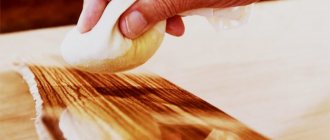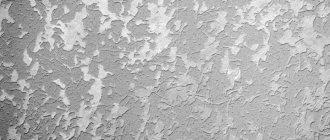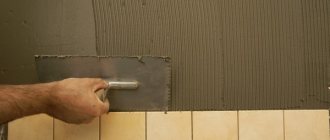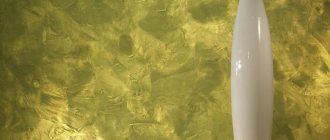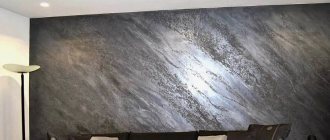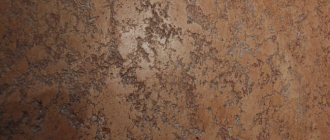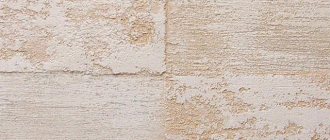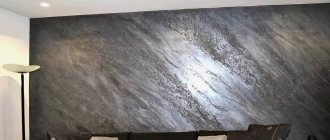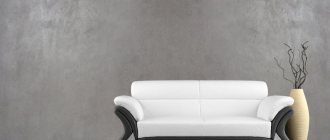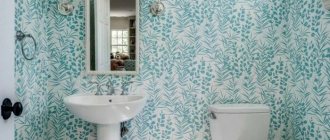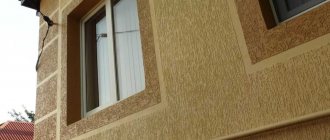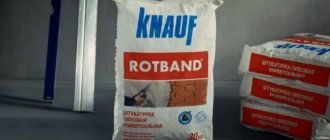The purpose of wet silk decorative plaster is indicated by the name of the material.
After all, as you know, plaster is intended to level the walls in an apartment or house and create a decorative effect. Like any facing material, this plaster has its own characteristics in application. The key to a high-quality coating is a carefully leveled and prepared surface. To be more precise, the walls in the house should be perfectly smooth, without the slightest flaw.
This article will be useful for those who are interested in wet silk decorative plaster. Let's talk about the main advantages and disadvantages of this material for wall decoration. You will find out what features and nuances of plaster need to be taken into account if you decide to decorate the walls with your own hands, and most importantly, through what components and techniques you can create a pearlescent sheen of silk on the walls.
What is silk plaster
Decorative plaster liquid silk (or wet silk) is a building material for decoration, which is more like liquid wallpaper. Due to the fact that it has a velvety and smooth coating, it is called velvety.
It got its name not only because of its appearance, but also because of its composition. After all, the main ingredients of the plaster coating are silk fibers, small particles of cotton, cellulose, and water-soluble glue.
Color palette
The SILK PLASTER catalog of silk plaster offers you a huge variety of shades of silk wallpaper. They will help transform the interior of the bedroom, living room and children's room, creating a unique design for your home. At the same time, they are environmentally friendly. The catalog contains about 140 colors and shades. Thus, silk plaster “Provence” presents two new shades: cozy beige and dark gray.
The collection of French decorative coatings "PARITET DÉCOR" is presented. Their products are environmentally friendly and safe. Silk plaster in the interior will help create an imitation of marble or stone, making the interior of your home luxurious and unique. The company's product catalog presents the consumer with a huge range of finishing materials and coatings:
- Silk plaster
- Bark beetle
- Fur coat
- Liquid wallpaper
- Photo wallpaper
- Venetian plaster
- Loft concrete
- Travertine
- Marble plaster
Types of silk plasters for decoration
In the world of design and construction, such material is usually divided and distinguished into three main categories: texture, composition, final effect.
Based on the main positions, there are several types of silk plaster, which are actively used in construction:
- wet silk;
- crushed silk;
- smooth silk;
- stone structure;
- Venetian texture;
- with marble chips;
- rain;
- broken stone.
In addition to the structure and texture, these types also differ in their application to the surface. If the material is used incorrectly, the repair may become unusable or last a very short time.
- To get the “crushed silk” , the builder needs to apply an additional layer of the composition to the previously prepared coating. The secondary layer should be applied unevenly. For a more effective action, you can use a construction or dish sponge. After 20 minutes, the surface is leveled with a spatula;
- When performing predominantly circular movements, the repairman can get the “liquid silk” . These stains should be done using a roller.
Important! The primary coat should be applied with a Venetian trowel.
- The classic version is similar to the previous one. The only difference is that the secondary layer must be leveled;
- if you use the right pressure and also make sure that the running tool moves easily, you can get a structured surface ;
- For the “rain” , you need to apply the composition at an angle. The secondary coating is applied using a special device;
- “flowing silk” is done in sections. Using a trowel, the solution is applied to the surface, after a couple of minutes you can create a pattern using diagonal movements of the trowel, you should get a pattern similar to flowing silk fabric.
Important! Make sure that the movements are intermittent.
Textured plaster is used to apply colored patterns. The result is very similar to wet painting. The ornament is created using colored paste.
Before you start decorating the main sections of the walls, it is worth practicing on the areas where the furniture will be placed.
The process of applying material with photos and videos
Silk plaster in the interior of a room
How to apply silk plaster correctly? The order of applying the mixture is arbitrary; hold the trowel at an angle. The first layer should be no more than 2 mm. When processing corners, it is advisable to use a corner spatula to avoid defects in the work. Moving the spatula outward, we form the corners. Masters apply strokes to the surface as follows:
- Using the “moon” technique, we make circular movements with the tool.
- The “droppe” method is chaotic small strokes.
- Using a roller with various attachments, we can achieve the effect of crinkled silk, velvet, or velor.
- Using a stencil you can make a relief design.
The second layer is final, it is advisable to make it as thin as possible. Then the effect will be amazing.
How to choose a building material
When choosing “liquid silk” plaster, you should focus on the manufacturers, as well as the quality of the building material produced.
Which companies does the online shopping service recommend:
- Decorazza Velluto - cost for 5 liters 9,500 rubles;
- VGT “Gallery” – cost per 1 kg 800 rubles;
- DALI-DECOR - cost for 2.5 liters 2500 rubles;
The best option is to buy a dry mixture and dilute it yourself. The Gallery company provides a large selection of dry compositions in various colors. Available in 1 kg and 6 kg packaging, fairly affordable prices and a large selection.
Photos in the interior
Examples of plastering under “wet silk” in the interior in the photo below:
On the walls in the bedroom
In the living room
In light colors
Turquoise coating
Pearlescent wet silk
Matte velvet
Beige shade
Smooth "Chinese silk"
Advantages and disadvantages of silk coating
Like any building material, silk coating has its advantages and disadvantages. Before you start working with the coating, you should carefully study them and make a choice “for” or “against”.
Benefits of silk coating
If we compare the two indicators, the advantages of silk coating are much greater than the disadvantages.
What are the main advantages of this coating:
- aesthetics and attractive appearance of the coating;
- the mixture has a hypoallergenic composition, which allows repair work to be carried out without additional protection;
- silk plaster is not susceptible to mold and mildew;
- has no unpleasant odor and does not attract dust;
Reference! The coating is resistant to fire.
- creates a favorable indoor microclimate;
- silk plaster retains its original appearance for a long period of time and does not need restoration;
- heat and sound insulation of walls;
- seamless surface that allows you to give the room a special charm;
- does not require special care: dust accumulations are removed with a vacuum cleaner, dirt with a rag soaked in a soap solution.
Reference! The coating has an interesting feature of absorbing and hiding odors in the room. If the owners do not want the coating to absorb third-party aromas, they can coat it with construction varnish.
Also, some types and manufacturers have quite affordable and low prices. These advantages set decorative silk coating apart from a number of other coatings. What are the disadvantages of the coating?
Flaws
If we talk about the disadvantages of plaster, then there are significantly fewer of them than the advantages.
What are they:
- silk coating has the ability to “pull out” dirt from the surface to which it is applied. Therefore, before applying the coating, you need to thoroughly clean the base;
- due to the active absorption of moisture and surrounding odors, this coating is not recommended for use in the kitchen and bathroom;
- with active contact with: furniture, people and animals, it quickly loses its appearance and needs restoration.
In other words, there are many more advantages, and the disadvantages can be taken into account and completely eliminated.
Ceilings
The final finishing of the ceiling is carried out using various materials. Liquid wallpaper is increasingly being used in residential and office spaces. The prototype of decorative plaster has many advantages, one of which is ease of application. By following simple technology, you can create a neat coating that will harmoniously blend with the interior in a few hours. More experienced craftsmen create multi-colored ornaments and complex compositions using liquid wallpaper.
Features of using liquid wallpaper
Liquid wallpaper is a complex mixture of cellulose and cotton fibers. An adhesive composition is used as a binder, and a dye is added to give the material the desired color. Liquid wallpaper is universal and practical to use - it is suitable for finishing offices, living rooms and rooms with high humidity.
The use of liquid wallpaper for the ceiling has a number of advantages:
- ease of working with finishing materials;
- a wide range of decorative fillings - a variety of colors and textures of the coating;
- “liquid” plaster coating organically combines with different interior styles;
- aesthetics of finishing - the result of the work is a seamless surface, which is especially important when arranging multi-level ceilings;
- maintaining a normal microclimate in the room - the use of organic components allows the coating to breathe, preventing the appearance of “stuffy” air and mold;
- the service life of decorative silk plaster is about 10 years - the damaged area can be restored;
- during the finishing process, an elastic coating is formed on the wall, which does not crack or deform when the house shrinks (relevant for new buildings);
- due to the fibrous structure of the material, additional heat and sound insulation of the ceiling panels is provided;
- the decor does not fade under the influence of sunlight.
The name of the finishing material is determined by the method of manufacturing and applying wallpaper. Cellulose shavings are supplied dry and must be adjusted to the desired consistency immediately before use. The installation method is similar to the technology of using decorative plaster, which is why liquid wallpaper is often called a type of this coating.
The disadvantages of innovative wallpapers include:
- relatively high cost compared to the traditional finishing method;
- Despite the moisture resistance declared by the manufacturers, such a coating cannot be equated to washable wallpaper.
Choosing the right type of wallpaper for the ceiling
Technical characteristics, decorative properties and durability of the finish largely depend on the type of the main component of liquid wallpaper. Four types of compositions are used as the finishing ceiling coating:
- cellulose;
- cotton;
- silk;
- combined.
Cellulose wallpaper consists of cellulose fibers, plasticizers and glue. Some samples are supplemented with decorative components. Distinctive qualities of the material:
- high adhesion strength of the finish to the base;
- susceptibility to UV rays - wallpaper fades very quickly in the sun, so it is permissible to use it in rooms with artificial lighting: corridor, bathroom, etc.;
- low cost.
The cotton covering consists of 98% natural fibers, 2% consists of adhesive binders, mica impurities and additives. The wallpaper is pleasant to the touch.
Silk products are strong, durable wallpaper that does not fade in the sun. Ideal for finishing rooms with large windows. The use of decorative additives allows you to give the coating a different texture - imitation of fabric, knitted patterns or marble. Perhaps the only drawback of such wallpapers is their high cost.
Combined compositions are the optimal balance of the positive characteristics of cellulose and cotton-silk models in one product. The pricing policy of the assortment varies depending on the percentage of different fibers and decorative impurities.
Liquid wallpaper application technology: step-by-step instructions
The technique of working with liquid wallpaper is very simple. However, to obtain a high-quality result, it is necessary to adhere to a number of rules when mixing the solution, preparing the base and applying the topcoat.
Calculation and preparation of materials
When purchasing wallpaper, you should correctly calculate the quantity. It is advisable to buy the entire batch at once, since the next time you buy, you may not be able to guess the tone correctly. The required material is first calculated.
Wallpaper packaging always indicates the area to be covered with a layer thickness of 1-1.5 mm. As a rule, a 1 kg package is consumed for 3-6 sq.m. The range of values is determined by the type and levelness of the base.
Knowing the area of the ceiling, calculating the number of packages of dry mixture is very simple - divide the area of the room by the recommended area to be covered by the manufacturer. In this case, the minimum values are taken into account.
Important! It is better to purchase wallpaper with a small margin. The remainder of the material will be useful in the future when carrying out restoration of the finishing coating
Tools for applying liquid wallpaper:
- plastic or metal containers for mixing decorative mortar;
- trowel or spatula for applying material;
- rubber roller – a structural roller is used to form a relief coating;
- half-grater
To apply “plaster” using the mechanical method, you need to prepare a spray bottle.
Preparing the ceiling for finishing
Before applying liquid wallpaper to the ceiling, you need to properly prepare the base. The quality of the first stage determines the level of adhesion of materials. The solution adheres well to OSB boards, clay, wood, cement, brick surfaces and plasterboard sheets. Preparatory activities are limited to ensuring the following requirements:
- absence of separating areas on the ceiling;
- moderate moisture absorption.
The procedure for preparing the ceiling for applying liquid wallpaper:
- Remove the remains of the old coating from the surface: wallpaper, plaster, etc.
- Check the evenness of the ceiling and, if necessary, level the base. With minor differences, leveling can be neglected - the defect will be smoothed out when applying the decorative layer. Fill visible cracks with putty.
- Prime the surface. For work, it is advisable to choose a white composition. Alternatively, you can use white water-based paint.
- Cover metal elements (corners, anchors, fittings, etc.) with oil or latex white enamel.
- To make the base rougher, use a primer emulsion with quartz dust or add fine sand to the primer yourself.
How to apply silk plaster
Having understood the main types and advantages of silk coating, it is worth considering the method of applying and preparing the solution.
As a rule, when purchasing a mixture, the method for preparing the decorating composition is written on the packaging. This may differ depending on the manufacturer and type of plaster.
As a rule, the plastering base is applied in the following way:
- with their hand they scoop up a lump of mixture of impressive size. Another option is to rest it on a trowel;
- Using a trowel, this lump is smoothed out from the middle and on the sides. It is important to monitor the thickness of the layer; it should be within 2 mm.
Reference! The thickness of this layer directly depends on the consumption of decorative material.
- in the corners, decorative silk plaster is smoothed using a narrow spatula;
- in order to apply the coating on the ceiling or the top of the wall, use a stepladder;
- When errors appear, they must be quickly applied with a spatula, and then a new layer of plaster base must be applied.
Important! Decorative plaster cannot be applied to an old coating. It can quickly crack and fly off, requiring dismantling and re-repair.
This is what concerns the procedure for applying the mixture to the base. It is important to carefully monitor the layer of decorative silk, as well as the technique of its application.
How to properly prepare decorative plaster? Of course, if at the time of purchase the builder did not specify how such a coating is made, you should independently find out how to prepare the decorative base.
How to make your own mixture
If you do not have experience, it is better not to experiment with the preparation of decorative compositions. To prepare decorative wet silk plaster with your own hands, you will need to follow the proportions. The composition of the finished solution includes:
- water;
- polyester;
- cellulose;
- cotton;
- natural silk fibers;
- acrylic additives (used as a substance that increases adhesive properties).
To prepare the finished solution, it is important to follow the manufacturer's recommendations on the packaging.
How to prepare silk plaster
In order to properly prepare a decorative coating, you need to prepare tools and materials.
These include:
- dry mixture for silk coating;
- trowel;
- water;
- spatulas;
- rags;
- ladder.
To prepare the composition, you need to fill it with water and mix thoroughly. After it is completely prepared, you can begin tiling the room using an unusual coating.
How to apply liquid wallpaper to the ceiling
Liquid wallpaper is a practical, beautiful and quite economical modern material, as a result of which owners of houses and apartments are increasingly giving preference to it when decorating ceilings and walls. True, the process of applying this coating is fundamentally different from working with conventional wallpaper, and contains a number of nuances. Therefore, below we will look in detail at how to apply liquid wallpaper to the ceiling to ensure a high-quality and durable finish.
Ceiling finished with liquid wallpaper
Technology of applying decorative plaster
If you follow the instructions provided exactly, you can easily and quickly prepare a high-quality silk coating. Where to begin?
Surface preparation
Without surface preparation, all work will go down the drain. You must first remove the old cladding material, thoroughly clean the surface of dirt, and only then can you begin the cladding process.
Important! Don't forget to clean really thoroughly. Otherwise, the coating will absorb all the dirt and lose its aesthetic appearance.
Applying the composition in one layer
After thoroughly cleaning and priming the surface, you can begin to apply the coating. This is done quite simply, the main thing is to monitor the thickness of the coating.
Using your hands or a spatula, scoop up a lump of coating and distribute it evenly over the wall: from the center to the edges.
Applying the composition in two layers
Depending on the chosen technique and pattern, a secondary layer can be applied.
Important! Make sure that the first layer has time to dry. To do this, let the coating sit for about 20 minutes.
Only a correctly carried out installation procedure will help achieve a beautiful and aesthetic effect. Do not forget about the rules of application and the type of primary coating.
To create some types of silk patterns you need to use a Venetian base, for others a regular one will do.
How to create patterns and designs
To create patterns and designs when applying decorative plaster with wet silk, you will need to use stencils or templates. It is also permissible to use optical instruments for transfer to the surface by projection.
Images and patterns are drawn with a narrow spatula or tinted acrylic paint.
Making a multi-color composition
In order to create a multi-color composition you need:
- Take two plasters of different colors;
- Mark the desired design on the wall;
- Prepare the mixture for application;
- Trace the outline of the element, then fill it with paste, according to the technology;
Important! If errors appear, cut off unnecessary areas with the sharp part of a spatula;
- Gradually fill the composition.
If you carefully follow all recommendations and instructions, you can create a unique design in any room of a residential building.
Features of liquid wallpaper
The material includes:
- Natural cotton.
- The dye is synthetic.
- Fibers.
- Cellulose.
- Silk.
The last two components help liquid wallpaper acquire greater elasticity.
The advantages of the material are:
- They are not subject to rotting - they contain antifungal inclusions, which allows their use in the bathroom and toilet, in rooms where there is high air humidity.
- Antistatic properties - dust does not accumulate on them.
- When gluing wallpaper, no adjustment of the pattern is required due to the absence of joints. After application, liquid wallpaper becomes a continuous canvas, which allows you to hide small differences, pits and cracks.
- When applying such material, no special knowledge is required ; a person who has nothing to do with apartment renovation can handle this task perfectly.
- After the material has completely dried, the ceiling can be painted in any color..
- Before applying liquid wallpaper with your own hands, no preparatory operations are required . They are applied to existing putty or paint, and will adhere to them excellently.
Tip: The whitewash on the ceiling should be washed off. And remove large differences on the surface with putty (see How to putty a ceiling with your own hands correctly) and re-prime.
- Liquid wallpaper is very easy to dismantle.
The disadvantages of the material include:
In appearance, liquid wallpaper is more reminiscent of a silk bedspread and with ordinary glass, non-woven and paper wallpapers it will not look aesthetically pleasing.
Tip: Before deciding whether it is possible to apply liquid wallpaper to the ceiling, you need to find an option that is suitable for finishing the walls or cover them also with liquid wallpaper.
What types of material exist and its characteristics
Liquid wallpaper is an original coating for application to walls and ceilings, reminiscent of a mixture of decorative plaster and paint.
The classic components of such a coating are:
- Cellulose fiber.
- Binding material.
In addition, it contains:
- Special dyes.
- Fabric fiber.
- Dry seaweed.
- Shredded tree bark.
Tip: Liquid wallpaper should not be used where it may come into contact with water.
When used in the kitchen, it is better to use for an apron:
- Tiles.
- Mosaic.
- Other waterproof materials.
Liquid wallpaper fits well on plasterboard sheets, but in this case it is necessary to prepare the surface in advance, which consists of:
- Puttying joints (see How to putty drywall joints according to technology).
- Painting over screw heads.
- Surface primers.
- Stripping drywall sheets.
- Applying liquid wallpaper.
When using the material, you can make patterns on the ceiling (see Liquid wallpaper and patterns: application technology). This is quite simple to do, but it will take quite a lot of extra time, much more than with conventional surface decoration.
To draw a picture, you will need to perform the following steps:
- A drawing is applied with a pencil to a prepared dry surface.
This should be done very carefully, checking the size compliance several times; then different shades of liquid wallpaper will be applied according to this sketch.
- When applying coating it is important:
- wallpaper color and number in the selected pattern;
- idea and complexity of the sketch.
- Carefully apply the desired design elements to the prepared wallpaper.
- Using a small glass spatula, press the wallpaper mixture along the edges of the pattern.
Dismantling and transferring silk trim
Sometimes a situation arises when you get tired of the old silk wall covering, and there is a desire to change the decorative plaster to a new coating.
Silk wallpaper is moistened generously with water. After this, the wet coating is carefully removed from the fence with a spatula, so as not to damage the base of the wall.
The removed material is dried and stored in a plastic bag. The finish can be stored for several years.
When the need arises, the dried wallpaper is removed from the bag and diluted with water. In the new place, the silk finish will look like a fresh coating.
Creating the effect of “silk threads”
“Silk threads” is a technique for applying decorative plaster, with the help of which a relief coating is obtained with long and thin vertical stripes across the entire surface. To create it, use the same acrylic plaster that is used for the “wet silk” coating.
This is what the texture of the plaster looks like
"Silk threads" in the interior
Horizontal stripes
With color transition
For work you will need: the same tools + a decorating brush or a brush with stiff bristles.
Advice! If you have no experience in performing such work, it is recommended to first practice on a small area of a smooth surface, such as a sheet of drywall.
Application technique:
- Prepare the base, apply a primer and leave until completely dry (12 hours).
- Cover the prepared surfaces with 1-2 layers of interior paint. Thanks to this, the hardening time of the plaster will increase, which will allow high-quality “threads” to be formed on the surface. Allow at least 2 hours between coats to allow the paint to dry.
- Acrylic plaster is thoroughly mixed and poured into a cuvette.
- The composition is applied using a fur paint roller. Layer thickness – up to 1 mm. If applied evenly, each square meter will require about 500 g of plaster. If they work alone and the surface area is large, treat 1 m² areas sequentially.
- Using a brush to leave streaks on wet plaster
While the material is not dry, use a plastic decorative brush to form the necessary relief. To do this, apply a brush to a wall covered with plaster, move it up and down, creating long vertical stripes.
- Before the solution hardens, you need to smooth the surface with a plastic spatula. During the process, excess composition will collect on its working edge; it must be removed with a clean rag.
- After the desired relief has been created on the surface, it is left to dry for 24 hours.
- Proceed to creating the finishing layer. Apply decorative varnish using a paint roller. While it is still wet, remove excess with a Venetian trowel. The pearlescent pigment penetrates into the recesses and is almost wiped off from the smooth surface, emphasizing the relief and enhancing the decorative effect. The varnish dries within 24 hours.
How to make “silk threads” in the interior yourself is shown in the next master class.
Silk-like decorative plaster is an elegant coating that is practical. Using various techniques, you can use it to decorate the walls of your kitchen, bedroom or living room in an original and stylish way.
We hope that the article was useful to you. Leave your feedback and questions in the comments below.
Previous
Decorative plaster "American" - a quick way of decorative plastering
Next
Decorative plasterShagreen from plaster: cheap and quick wall decoration
Wet silk plaster - pros and cons
Liquid wallpaper appeared on the sales market only in the late 90s. In such a short period of time, they have already managed to gain great popularity and form a profile about themselves. Silk-effect decorative plaster has a number of advantages:
- Recommended by experts.
- Excellent fit on uneven surfaces and corners. Seals small cracks.
- Eco-friendly material.
- Has antistatic properties.
- Very easy to use, which will help you not waste your budget on employees.
- Is fireproof.
- Can be applied to both ceilings and walls.
- Odorless, does not contain toxins, does not cause allergies.
Repair of damaged areas of the coating
If, as a result of someone’s careless actions, the surface of wet silk was damaged, then the homeowner can independently make repairs. They do it like this:
- The damage area is marked with a pencil;
- the damaged area within the contour is generously moistened with water;
- Use a spatula to carefully remove the soaked finish;
- if the damage is deep, then the wall is puttied and primed;
- the dry mixture from the remaining residues is diluted with water and the damage is rubbed with the finished mixture using a trowel;
- work done correctly will not leave any traces behind.
Many people value liquid wallpaper precisely for its durability and the ability to easily and simply repair wall decoration.
Troweling damage to silk plaster
